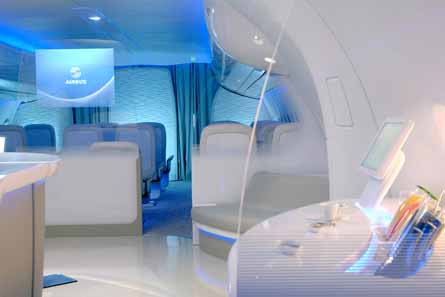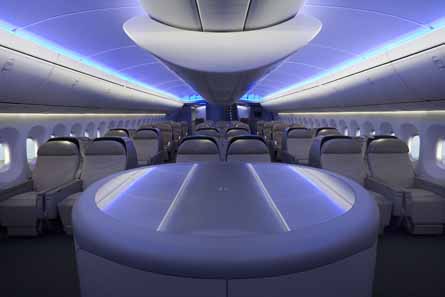Max Kingsley-Jones / London & Guy Norris / Seattle
The 'battle of the cabins' between Airbus and Boeing is heating up as the two vie to set the benchmark for passenger comfort in the next generation of airliners
When Airbus launched the A380 seven years ago, it captured the hearts and minds of the public - not to mention the consumer media - with talk of how the double-decker's unprecedented volume would provide new levels of comfort and gimmicks.
The prospect of duty-free shops, showers and bars for all classes gave Airbus an important marketing edge that kept it in the media's spotlight during the early days of the programme as it tried to establish the aircraft with the world's airlines. While some, if not all, of those promised features may start to become a reality from later this year when the A380 enters service, the fact is that its legacy is an ongoing "battle of the cabins" between the two industry heavyweights.
Click here to read 'Everything about the A380'...
|
|---|
Airbus's "cabin vision" mock-up forms the basis of the interior to be offered on the A350 XWB |
Airbus and Boeing will go head to head again at this week's Aircraft Interiors Expo in Hamburg as they attempt to win the public's imagination for their new programmes - the A350 and Boeing 747-8 and 787 - in the same way that the A380 did at the turn of the decade and the first- generation widebodies did 30 years ago.
The US airframer took some bold technical steps with the 787's design, and in parallel has run a strong marketing campaign that has sought to simulate some of that same public passion that was in evidence for the A380. Beginning with the name "Dreamliner" unveiled in 2003, from the onset Boeing has pitched the aircraft as much at the consumer as the industry, unveiling an impressive collection of ideas in a cabin mock-up that has since travelled the world.
Distracted by the A380, Airbus found itself playing catch-up to the 787 on almost every front, culminating in the redesign of its rival A350 last year as the XWB. Central to that redesign was a wider cabin, but the change came too late for the mock-up, which was built around the original A350 cross-section - itself identical to the A330/A340 - not to mention the A300/A310.
That mock-up, unveiled a year ago at the last Aircraft Interiors Expo at Hamburg, was quickly redubbed the "Airbus cabin vision" and any references to the "old" A350 quickly eliminated. This forms the basis of what will be offered in the A350, and the manufacturer says that an interior mock-up based on the wider cabin of A350 XWB will be completed before year-end.
Airbus has a "transnational" cabin interiors division that has a management team based at its Hamburg plant. The airframer works with a host of suppliers, customers and design houses on its future cabins, but the basic premise is to make the passenger "feel well", says Sophie Pendaries, head of aircraft interiors marketing division. "We focus on basics - the passenger will feel well if everything is working well."
There are four elements to the "basics", says Pendaries: spaciousness, lighting, quietness and on-board systems. The key driver for spaciousness is defining the "right cross-section". This can be accentuated by the architecture of the cabin with the introduction of the "horizon-line, which enhances the perspective", says Pendaries. "On the A350 this runs from door one to door four. We are also working on continuous surfacing to reduce monument volume."
One "gimmick" incorporated in the Toulouse A380 cabin mock-up that looks set to be a reality sooner rather than later is a two-berth private compartment designed to fit in the upper deck. "This will allow two passengers to travel together on long-haul flights - it is a totally new approach to selling tickets," says Pendaries.
Lighting scenarios
The A380 has a cabin lighting system that provides 16 million colours enabling 5,000 scenarios to be created. "This will allow strong airline differentiation," Pendaries says. In the longer term, Airbus is developing the lighting system to enable images to be projected on to the ceiling - a feature that it has incorporated into its "cabin vision" mock-up.
|
|---|
Larger, 777-style windows help to increase the feeling of airiness in the cabin of the 747-8 |
"When the A340-300 was introduced it was the quietest cabin in the sky. The A380 is the successor and it is not by chance," says Pendaries. "We achieve quietness by having an integrated team of acoustic, systems and installation specialists working together to make sure we achieve the quietness set at the design level. This starts with the fuselage shape, which has an impact on the airflow velocities - we did this on the A380 and are considering on the A350."
With mobile voice and data communications set to be an increasing reality in the cabins of airliners, Airbus is looking at how it provides different zones with different levels of noise. "We are looking at the possibility of having a clear separation between the galley area and the premium cabins - today you just have a curtain," says Pendaries.
New technology in the cabin in-flight entertainment systems also promises to improve the cabin. "We are using fibre-optics on the A380 to transfer IFE data, which significantly improves reliability as well as increasing the bandwidth, enabling airlines to offer a far greater selection of programmes," she says.
"The next step in IFE is establishing how we enable passengers use their own personal entertainment devices - for example iPods - on board. We have to look at certification issues and decide how far we want to go in connectivity," says Pendaries.
"There is demand from both the airline side and the passenger side. We can already offer the first step on the A380 through the GSM connectivity and we are working on the next step, but I cannot say any more for the moment."
With Boeing's marketing campaign for the Intercontinental passenger version of the 747-8 in top gear following the confirmation of the launch late last year by Lufthansa with its order for 20 aircraft, the manufacturer is eager to put clear blue water between the new aircraft's cabin and its legacy, the 747-400. And a glance through the door two main-deck passenger entryway of the 747-8I's cabin mock-up is all it takes to tell you this is not your father's 747.
Subtle blue-tinged lighting, sculpted curved ceiling and sidewall panelling, revised bins, a new flared staircase and a feeling of spaciousness convey a 21st century look to this 787-styled, 747-sized cabin. "We had good discussions with the airlines about whether and how to evolve the -400ER architecture, and we were strongly encouraged to go in the direction of the 787," says Boeing director of passenger satisfaction and revenue Klaus Brauer.
The right decision
"When we saw the finished mock-up we knew we'd taken the right decision," says 747-8 vice-president Dan Mooney, who adds that the interior redesign was part of a carefully considered balance between spending on an all-new configuration and a more affordable derivative. "It was more investment, but we've had some great comments, particularly about things like how we've pulled off the stairs," says Brauer.
The centrepiece of the double-deck mock-up, which can be seen at Boeing's customer experience centre near Renton, is the redesigned stairway. Although Boeing seriously considered relocating the stairs to the right side of the cabin, the airline interior working group advised against it. "It was a practical matter. We were always going to have a galley by door two, and if we moved it you'd see a lot of galley as you entered, and with the servicing there'd be a lot of cross-over during the turnaround," says Brauer.
The stairs, slightly flared from the base upwards, rise from an open atrium whose feeling of spaciousness is emphasised by bluelight-tinted "moon pool" recesses in the ceiling. The effect, reminiscent of the 787 interior and entryway, "gives you that same feeling of welcome", Brauer adds.
It's in the bins
At the top of the stairs another new open area has been created by the deletion of the large closet normally situated here. This has been made possible by the use of "honest to goodness" 777-style overhead bins on the upper deck. The popular sidebins on the -8 will also be deeper than those on the -400 due to revised depressurisation relief venting requirements. The upper deck ceiling is also smoothly contoured, the surface now running level with the waterline of the internal frames rather than conformally to give the ribbed effect in the current -400.
Consideration was also given to using more of the upper spaces aft of the forward upper deck, but the location of several systems made this too costly, says Mooney. Launch customer Lufthansa, plus other potential operators, have shown strong interest in locating the galley and galley cart stowage in the aft upper space. The other upper space study for "Sky Lofts" has been shelved. "The airlines didn't know how to make revenue out of it," says Brauer, who adds that most studies relied on premium pricing for business class, which threatened to "cannibalise first class".
One of the more unusual, if subtle, differentiating aspects of the 747-8 will be larger, oval-shaped 777-style windows on the main deck and standard 747-400 windows on the upper deck. The change comes with Boeing's decision to opt for the more structurally efficient 777-style window belt construction method, and with it the twinjet's 388mm (15in)-tall by 273mm-wide windows.
On the main deck the "flat ceiling and boxy" look of the older 747 design has effectively vanished with the use of curved, 787-style interior arches and sidewall panelling. The main deck also has 787 overhead bins, "which is also good for our production system, and helps with concerns about the brand image", Mooney says.
Mixed operations
Boeing expects some 747-8 operators, like Lufthansa, to fly the aircraft in mixed operations with the A380. It also acknowledges that direct comparisons between the two are unavoidable, particularly by the flying public. However, the layout of the two behemoths has meant differing uses of floor area, says Brauer.
"In some areas around the forward stairs, where you can't have seating for passengers on the A380 they've made the most of it to provide very large lavs, whereas we haven't the same sort of unused spaces. We do, however, have Zone A [main deck forward section, an iconic area on the 747], so intrinsically you see they are different aircraft," he adds.
"We're not aware of any customers saying 'the A380 has this, why don't you'" says Mooney, who concedes that because "the A380 was all-new in terms of the interior it puts a bit of competitive pressure on us". Brauer, meanwhile, says: "I'd argue we have leap-frogged them in terms of architectural style."
Some final refinement work is still planned for the interior, including detailed systems decisions in areas like lighting and electrics, says Mooney. This is due to be wrapped up with the finalisation of the 747-8I configuration "in late summer or early fall", says Mooney. Assembly of the first aircraft is due to begin in early 2009 with entry into service due in 2010.
View our commercial aircraft directory...
For more news, pictures and information about the Boeing 747 please visit our 747 page
Source: Flight International




























